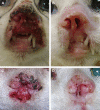Radiation therapy for feline cutaneous squamous cell carcinoma using a hypofractionated protocol
- PMID: 20034827
- PMCID: PMC11135594
- DOI: 10.1016/j.jfms.2009.10.005
Radiation therapy for feline cutaneous squamous cell carcinoma using a hypofractionated protocol
Abstract
The objective of this paper was to evaluate the efficacy of a hypofractionated radiation protocol for feline facial squamous cell carcinoma (SCC). Twenty-five histologically confirmed SCCs in 15 cats were treated with four fractions of 7.6-10Gy each, with 1 week intervals. The equipment used was a linear accelerator Clinac 2100 delivering electron beam of 4 or 6MeV, and a bolus of 5 or 10mm was used in all lesions. Of the lesions, 44% were staged as T4, 16% as T3, 8% as T2 and 32% as T1. Of the irradiated lesions, 40% had complete response, 12% had partial response and 48% had no response (NR) to the treatment. For T1 tumors, 62.5% had complete remission. Mean overall survival time was 224 days. Owners requested euthanasia of cats having NR to the treatment. Mean disease free time was 271 days. Side effects observed were skin erythema, epilation, ulceration and conjunctivitis, which were graded according to Veterinary Radiation Therapy Oncology Group (VRTOG) toxicity criteria. Response rates found in this study (52%) were lower when compared to other protocols, probably due to technique differences, such as fractionation schedule, bolus thickness and energy penetration depth. However, the hypofractionated radiation protocol was considered safe for feline facial SCC. Modifications of this protocol are being planned with the objective of improving the cure rates in the future.
Copyright 2009 ISFM and AAFP. Published by Elsevier Ltd. All rights reserved.
Figures



References
-
- Hand C.M., Kim S., Waldow S.M. Overview of radiobiology. Washington C.M., Leaver D. Principles and practice of radiation therapy, 2004, Mosby: Missouri, 55–85.
-
- Carpenter J.L., Andrews L.K., Holzworth J. Tumors and tumor-like lesions. Holzworth J. Diseases of the cat – medicine and surgery, 1987, WB Saunders: Philadelphia, 406–596.
-
- Ruslander D. Cutaneous squamous cell carcinoma in cats, Compend Contin Educ Pract Vet 19, 1997, 1119–1129.
-
- Moore A.S., Ogilvie G.K. Skin tumors. Ogilvie G.K., Moore A.S. Feline oncology – a comprehensive guide to compassionate care, 2001, Veterinary Learning Systems: Trenton, 412–418.
-
- Miller W.H., Affolter V., Scott D.W., Suter M.M. Multicentric squamous cell carcinomas in situ resembling Bowen's disease in five cats, Vet Dermatol 3, 1992, 177–182.
Publication types
MeSH terms
LinkOut - more resources
Full Text Sources
Medical
Research Materials
Miscellaneous

